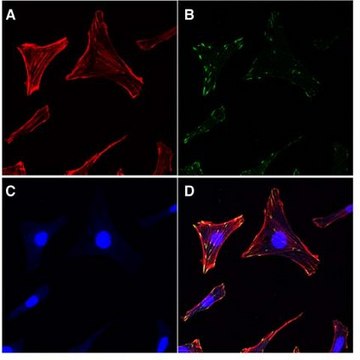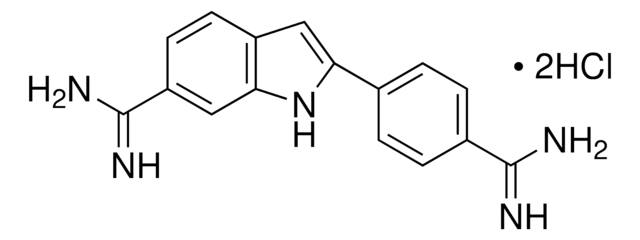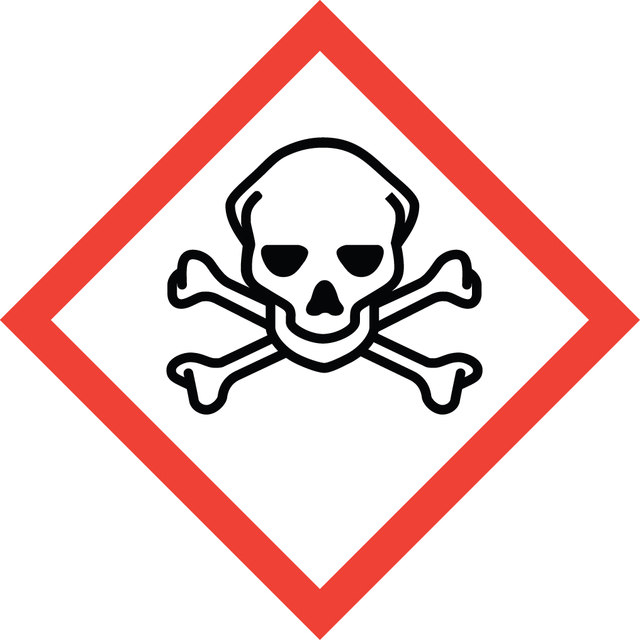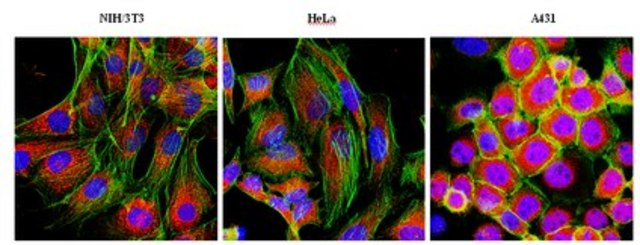P5282
Phalloidin Peptide
≥90% (HPLC), solid, FITC labeled
Synonym(s):
Phalloidin-FITC
Sign Into View Organizational & Contract Pricing
All Photos(1)
About This Item
Empirical Formula (Hill Notation):
C56H60N10O15S2
Molecular Weight:
1177.26
MDL number:
UNSPSC Code:
12352202
NACRES:
NA.32
Recommended Products
Product Name
Phalloidin, Fluorescein Isothiocyanate Labeled, sequence Amanita phalloides(synthetic: peptide sequence)
biological source
sequence from Amanita phalloides (synthetic: peptide sequence)
Quality Level
form
solid
fluorescence
λex 495 nm; λem 520 nm(lit.)
storage temp.
−20°C
Related Categories
General description
Phalloidin is a phallotoxin produced by death cap mushroom Amanita phalloides. It is a cyclic peptide, which interacts with actin and this was first identified in phalloidin-poisoned rats. It is a heptapeptide, cyclic in nature, with a crosslink between tryptophan at position 6 and cysteine at position 3. The side chain of amino acid 7 (γ-δ-dihydroxyleucine) in phalloidin, is accessible to modifications, through which fluorescently labelled phalloidin compounds can be produced.
Application
Phalloidin, Fluorescein Isothiocyanate Labeled has been used:
- To visualize F-Actin reorganization in primary neonatal cardiomyocytes (PNCMs) and H9C2 cells (rat cardiac myoblasts) following endothelin-1 (ET-1) and angiotensin II (Ang II) treatment.
- In immunochemistry to label microfilament.
- In immunofluorescence analysis to stain F-actin.
Biochem/physiol Actions
Phalloidin interacts with polymeric actin, and not oligomeric or monomeric forms. This interaction leads to highly stabilized actin filaments, which resist depolymerization and disassembly. In rats, this toxin causes death due to liver hemorrhage, and cells show abnormal actin clustering. The affinity of phalloidin to actin is not significantly altered after derivatizing fluorescently labelled phalloidin compounds. These compounds can be used to study actin structure and organization within eukaryotic cells.
Toxin that binds polymeric F actin, stabilizing it and interfering with the function of actin-rich structures.
Signal Word
Danger
Hazard Statements
Precautionary Statements
Hazard Classifications
Acute Tox. 2 Dermal - Acute Tox. 2 Inhalation - Acute Tox. 2 Oral
Storage Class Code
6.1A - Combustible acute toxic Cat. 1 and 2 / very toxic hazardous materials
WGK
WGK 3
Flash Point(F)
Not applicable
Flash Point(C)
Not applicable
Choose from one of the most recent versions:
Already Own This Product?
Find documentation for the products that you have recently purchased in the Document Library.
Customers Also Viewed
Our team of scientists has experience in all areas of research including Life Science, Material Science, Chemical Synthesis, Chromatography, Analytical and many others.
Contact Technical Service






